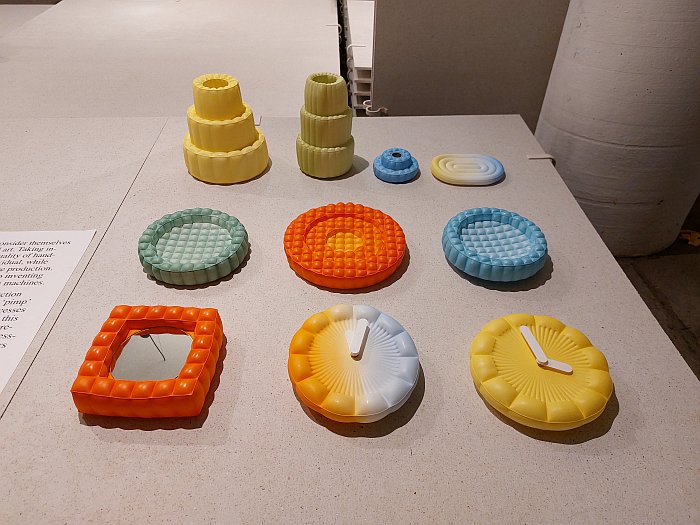There is an argument to be made that while variation and uniqueness are inherent features of craft processes, design strives for the production of endless uniformity.
Or perhaps more accurately design did: while the earliest design practitioners, and those of the 1920s and 1930s who followed them, very much (largely) sought to develop products that contemporary industry could produce en mass as exact replicas of one another, since the 1960s individuals and groups of designers have sought to move away from the design of the identical for a society that is diverse; have sought to develop either systems that allow for individual expression and individual adaptation and/or to develop production processes that inherently and intrinsically enable and foster and realise variety without fundamentally questioning the idea of industrial multiplication and reproduction.
With the showcase The Series Vienna Design Week 2023 allows space for reflections on approaches by contemporary designers to designing for variety, and thereby also for differentiated reflections on contemporary design.......
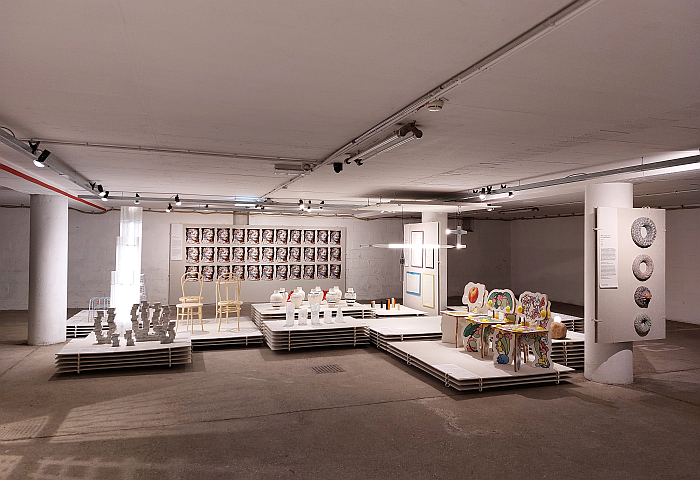
Staged in context of the Vienna Design Week Fokus programme, a new programme point launched in 2022, The Series features 13 projects by a roster of international creatives, arranged, presented and discussed by curator Laura Houseley under three broad headings: Nature, System, Waste. 13 projects which embody a variety of approaches to and understandings of the Series, the serial production, of the showcase/project title; 13 projects which for all they concern themselves with the variety and inconsistency of craft are design projects, and which in alluding to craft while being design approaches allow for reflections on the similarities and distinctions between the two; 13 projects which help elucidate that the research and development, often inter-disciplinary research and development, that leads to the processes for creating such series of almost identical objects is as much a part of what design is as the form-giving and visual aesthetics that design once was, and on Instagram still is; 13 projects which help explain how designers relate to the world around them and its processes and rituals, or at least explains how they can, and how those relationships, developments in those relationships, can affect all our relationships with the world around us and our objects of daily use. And thus 13 projects which although all very much of and for themselves, as a collection offer access to some interesting meditations on the whats, whys and wherefores of design. And of designers.
And while, and as ever, such a showcase is, and always should be, about considering each and every project as an individual in context of both the curatorial question/challenge and also in context of the other projects, and not about picking favourites, not about raising some projects artificially to a status above the others, a few projects did particularly catch our attention, are and were projects with whom we enjoyed, and are still enjoying, interesting conversations. Which is not to say the others didn't stimulate a conversation and/or interest; is to say we're unfairly reducing our viewing of The Series to the following trio.......
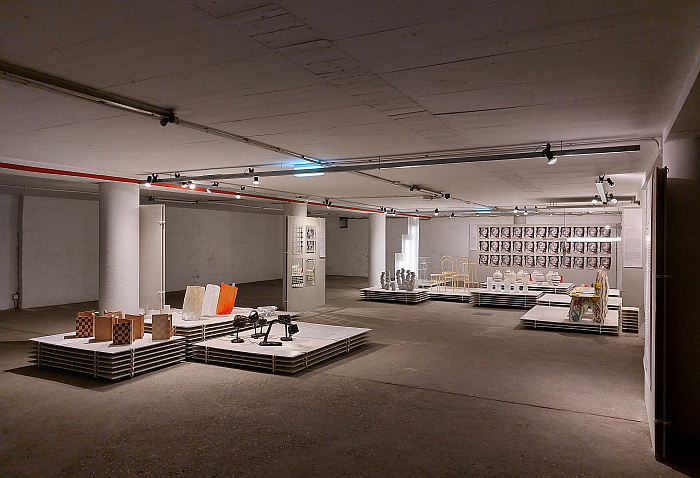
Reflecting back on the processes that led to what became the Eamses' DKR wire chairs Charles Eames noted in 1958 that at that time, in the late 1940s, there were "these fantastic things being made of wire — trays, baskets, rat traps – using a wire fabricating technique perfected over a period of many years"1, a novel manufacturing technique that Charles and Ray Eames were also keen to explore: it was one of those things they did, taking the processes and materials of contemporary industrial society and employing them for furniture. And that not least because during that immediate post-War period when the Eames' were at their most active, contemporary industry, contemporary mass industry, was going to solve all the problems of society, was the future; before it became the future, became the source of a great many of our contemporary problems, became pollution and environmental damage. Which is very much where the (hi)story of Discount begins; namely with abandoned shopping trolleys Heiko Bauer observed littering the streets of, we're assuming Düsseldorf where he is based, but we don't know, and such is in any case a universal reality. Shopping trolleys which were also one of those "fantastic things" developed from the new metal wire fabrication processes of the late 1940s, shopping trolleys which were very much a product, an invention, a necessity, of not only the immediate post-War belief in industry, but the immediate post-War belief in commerce and consumerism: if we all consumed enough industrial products, all would be good. The marketeers and politicians told us. So keep buying autonomous cars and flying taxis.
But shopping trolleys which also warned us of the approaching problems. Or more accurately Stiletto Studios' re-appropriated shopping trolley chair Consumer's Rest warned of approaching problems in both its criticism of the lazy, unreflective, financially motivated, objectification of design in place of an objective assessment, and also warned in its admonishment to reduce our consumption, to re-think our consumption, to re-think our shopping trolleys: not so much 'swords into ploughshares' as 'trolleys into chairs'. Yet Stiletto Studios' admonishment to consumers to rest, went unheeded. The shopping trolleys rolled on.
And thus those contemporary shopping trolleys abandoned in and on urban streets and rivers can be considered a consequence, ¿an inevitable consequence?, of the society mass industrialisation and mass consumption helped create; abandoned shopping trolleys littering the streets and rivers as a symbol of a society they helped establish and we all embraced, before it broke. Which is poetic in itself. Certainly, we'd argue, worthy of an expensive coffee table photo book of abandoned shopping trolleys.
Discount stands, we'd argue, very nicely as the next step in that progression from the shopping trolley as a symbol of hope, to the shopping trolley as a warning of the coming problems, to the shopping trolley as an embodiment of a contemporary malaise... and now as a proposal in context of the urgent need to re-imagine and re-define society, to question the society we want and consider how we want to get there. And the role re-cycling, re-using and re-straint can, could, ¿must?, play in approaching those answers.
Whereby the title Discount doesn't necessarily point in a good direction, certainly for our part we're not sure we want a future society built on the cheap. But we see what Heiko means.
Aside from such considerations Discount also very much appealed to us as an actual object, as actual objects, as an open, aerated shelving and storage system with a very obvious nod to Postmodernism, and which is/are well suited to and for a variety of locations, and, no, not just student kitchens, Hipster clothing stores or museum bookshops, although those three do particularly come to mind. In addition the use of the flap from the child's seat as shelving is a very nice detail; very simple but very satisfying.
And Discount is also an an excellent and apposite reminder, perhaps primarily an excellent and apposite reminder, for us all to better define the term 'material'; to move away from understandings of a material as something one consumes to destroy and to appreciate that materials exist all around, are always there, the challenge being first to identify them and subsequently to develop meaningful systems for their sustainable and responsive utilisation. Thoughts which bring one back to a Charles and Ray Eames and their use of off-the-shelf industrial products in new contexts for the construction of their house in Pacific Palisades, California: the arguments and positions have been around for a long time, have been valid for a long time, but have been ignored by wider society for far too long. That must change.
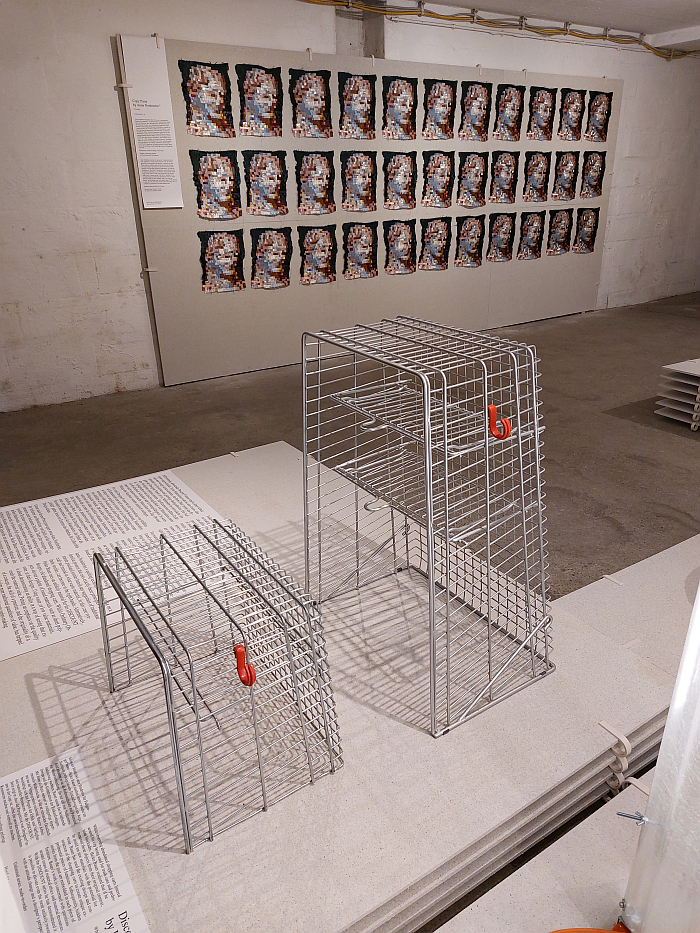
For all that hand crafted wooden chairs are today prized for their perfection of material and construction, back in the day, certainly for the chairs of the normal, unwashed, peasantry, 🙋, as opposed to those preserved in historic castles and palaces and manor houses by the likes of Klassik Stiftung Weimar, the wood would have been of variable quality and the construction often indifferent. Rustic we'd call it today. Which is arguably also what the wealthy residents of 17th century England called their so-called Forrest Chairs, objects which just possibly could, potentially, have been an earliest manifestation of the Windsor Chair; and Forrest Chairs which, according to contemporary 17th century accounts, graced the grounds of the sort of castles, palaces and manor houses with higher quality interior furniture, as "natural" garden furniture. Which, yes, does sound like contemporary furniture marketing.
'Natural' garden chairs that while they could have been exquisitely carpented, in all probability would actually have been but rough sticks elementarily bound to one another, sadly no photos exist, it was the 17th century ¯\_(ツ)_/¯; and which if they were very much find an echo in the highly enjoyable faux tree branch metal chairs that populate the gardens at Schloss Pillnitz, Dresden, almost in defiance of the decades of horticultural and botanical research undertaken by the Sächsische royal family in those very gardens. And also find an echo, albeit a more satisfying and honest and meaningful echo, in the project Branchwood by Vienna based Jakob Niemann; a project concerned with, and simplifying to the point of inaccuracy, developing more sustainable and responsive approaches to the farming of wood for furniture — Jacob employs branches cut so that they grow again, and occasionally formed before being cut — and project which features, amongst other objects, arguably as the key object thus far, the so-called Branchwood Nr.4 a re-interpretation of Michael Thonet's famed Nr.14 bentwood chair, produced via a very similar hot wood bending method; albeit wood not only proudly displaying its knots and burls, but that also hasn't been standardised and straightened prior to bending. Presents itself as it was taken from its tree.
And thus a work, a juxtaposition with Thonet's chair 14, which on the one hand allows one to focus on Michael Thonet as a pioneer of industrial production through standardisation, a position that Michael Thonet is far too infrequently allowed to popularly take, not least through the focus on the apparent craft of wood bending, or put another way Michael Thonet could have featured in The Series had it been staged in 1856; and which on the other hand allows one to better approach considerations on where the standardisation and optimisation and industrialisation of the last 100+ years have brought us, why that path, why this location, were there alternatives, and how do we want to progress from this point. Where do we want to go?
Thoughts which can take one, certainly took us, back to Schloss Pillnitz, back to Plant Fever. Towards a Phyto-centred design, and the consideration on the consequences of the standardisation and optimisation and industrialisation of plants that was enabled by the sort of botanical and horticultural research of the late 19th century, and from there to the vast number of trees Thonet needed for their production, the vast number of beech trees, Thonet having access to untold acres of monoculture beech forest across central Europe; and thus to reflections on the fact that the materials we employ, and the methods we employ, for our objects of daily use, help define the natural environment. And thus changing how we produce, changing the materials we use and how we source them, can be a component of achieving for a more balanced co-existence with nature. See also Discount.
And leads one to question why Schloss Pillnitz have metal faux wooden benches in their carefully landscaped gardens. We've not been out to Schloss Schönbrunn yet to check out their garden benches, but we will try to make it.......
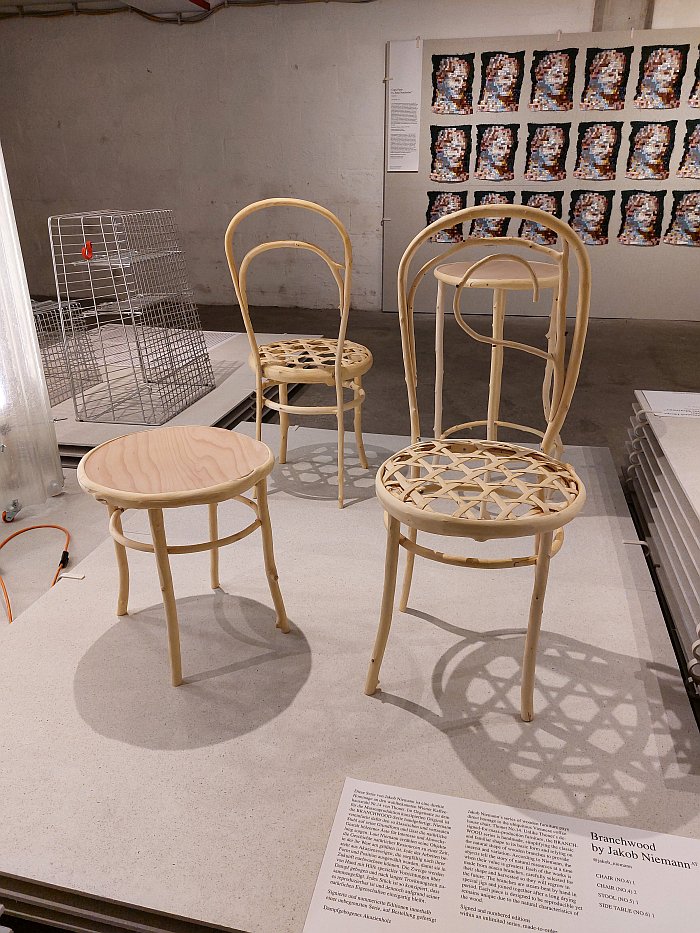
As oft discussed in these dispatches, amongst the many advantages 3D printing brings with it is the possibility to add variation during a production run, and for all the ability to change forms without overly interrupting the production process, and certainly without creating expensive new moulds, tools etc....
That, however, clearly wasn't enough for Eindhoven based, ECAL Lausanne graduate, Leo Koda and thus in his project In Fill Out he does something additional. Something truly outrageous. Joyously impudent: he boils his 3D printed objects.
No, really.
Boils them.
As we all know, but all need Leo Koda to remind us, if you heat air it expands, ergo if you heat a flat, air containing, 3D structure, for all a structure printed in PLA which is pliable at raised temperatures and solid at room temperature, the object that was once flat puffs up.
Which not only completely changes the object, realises a completely new formal expression, and occasionally a new functionality, but fundamentally alters how you respond with it, how you interact with it, how you adopt it into your life. It's like meringue.2
Except it isn't.
For while meringue grows and expands randomly, the clever part of Leo's approach is his concentration on the infill, the, if one so will, internal supports that 3D printers need to print to give objects stability, which meringue doesn't have; and infill which most amateurs rarely reflect upon when 3D printing, tending to employ the standard, pre-defined, formats at general densities when splicing. Leo reflects on the infill, uses that infill, the infill is, if one so will, his primary tool. That a pot of boiling water.
Infill which defines the formal expression of the end object: the decoration is structural, the decoration is functional, the decoration is decoration. One could, arguably, compare it to Gothic architecture and/or Brutalism. One could certainly compare it to the ca. 1961 wooden chair by Slovak designer Viktor Holešťák-Holubár as presented in Retrotopia. Design for Socialist Spaces at the Kunstgewerbemuseum, Berlin, whose single dovetail joint in the middle of the backrest is both the structural core of the work and also its defining decorative feature. And a work inarguably influenced and informed by craft traditions. But is In Fill Out? We're still working on that question.
And for all that the results of Leo's boiling of PLA resemble spongy objects, and in several cases could be confused for ASMR Pop-Its, they are in actual fact rigid; which can be a bit discombobulating. You just know they squash. But don't. Its not meringue. But could it be more than that presented in Vienna? Could it be a chair? We're certainly hoping Leo tries.
And for all that many of the results of Leo's boiling of PLA will invariably be delighted over on social media for the retronicity, they are anything but, they are very forward looking, challenging, exploring objects and positions, which seek to, promise to, allow design and our objects of daily use to evolve and develop, and thus are an excellent, joyous, reminder of the dangers of focussing on the visual expression alone, and of the importance of always looking beyond the superficial of an object or a process. Which, yes, could be a metaphor for society.
For all in or near Vienna, The Series can be viewed in the Vienna Design Week Festivalzentrale in Prater, 2.,Laufbergergasse 12 until Sunday October 1st
1Olga Gueft, 3 Chairs/3 Records of the design process 1: Charles Eames Leisure Group, Interiors CXVII, No .9 (April 1958): 118-22, reprinted in Daniel Ostroff [ed.], An Eames Anthology: Articles, Film Scripts, Interviews, Letters, Notes, Speeches, Yale University Press, 2015, 167-170
2Arguably foodstuffs that pop up in boiling water, or oil, are a better analogy, for example, Kräpfen/Berliner/Donuts, but we did very much like the meringue analogy. Also because meringue is very brittle, and often squidgy. But please feel free to develop your own analogy......
Full details, and a list of all participants, can be found at www.viennadesignweek.at/the-series
